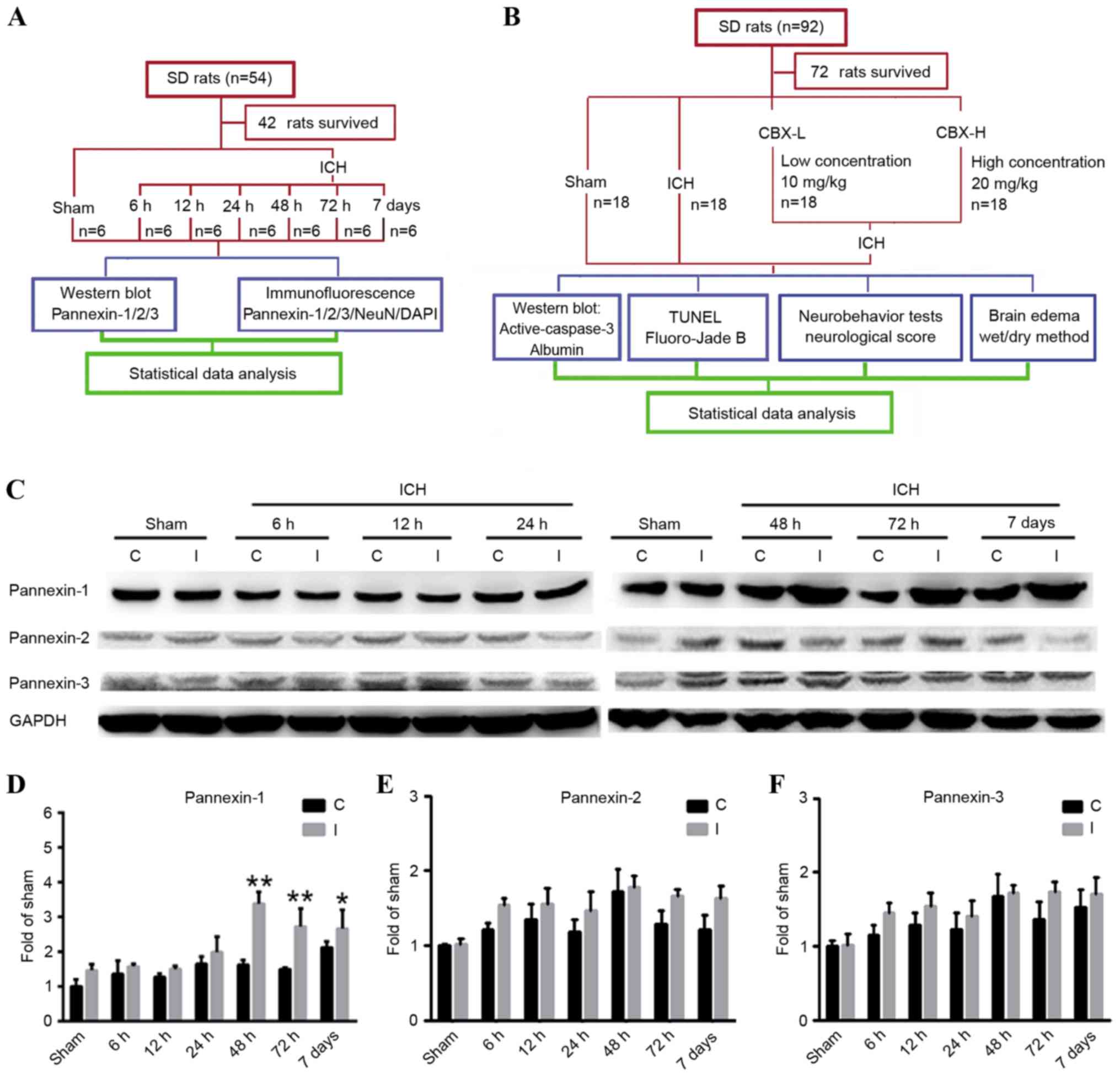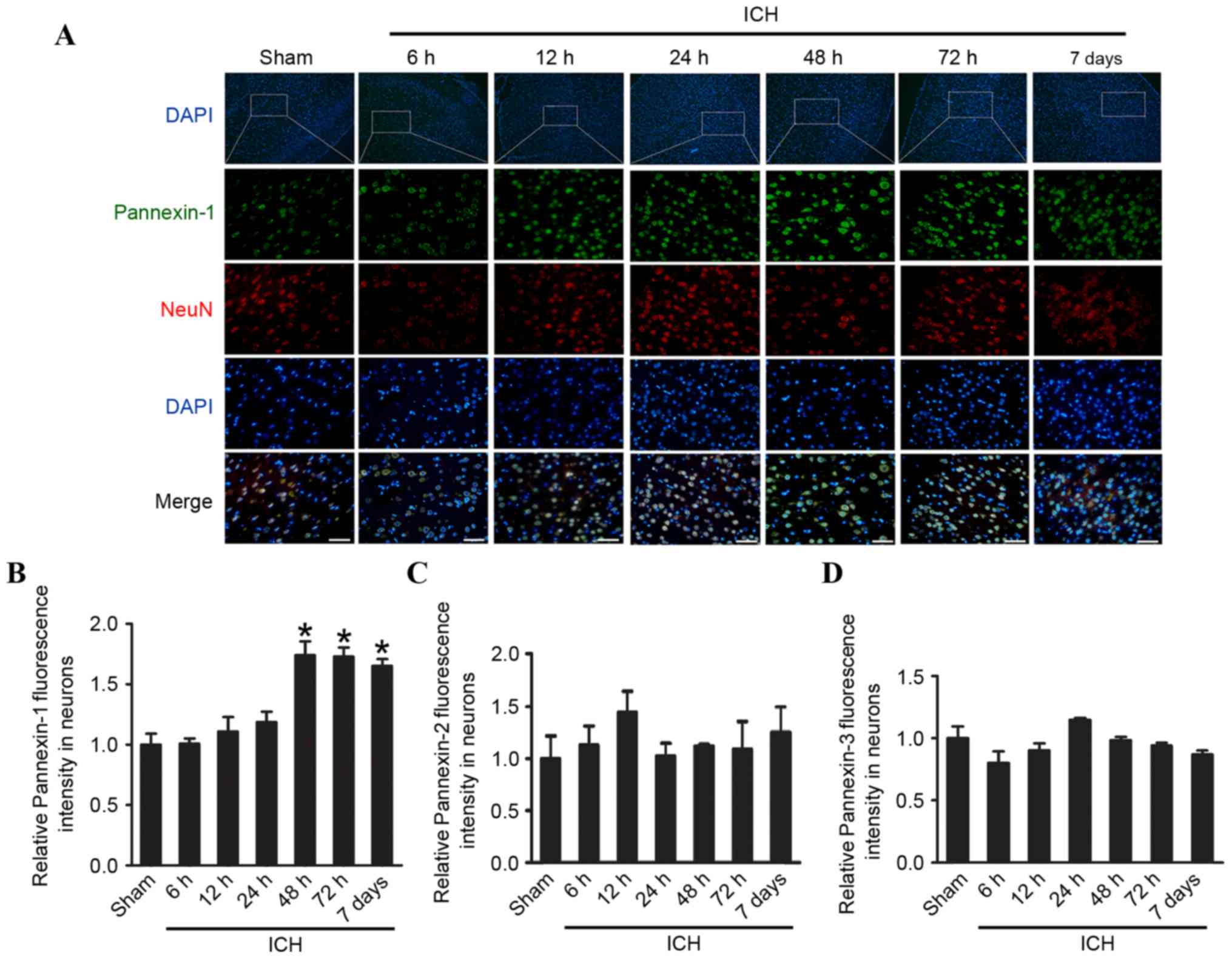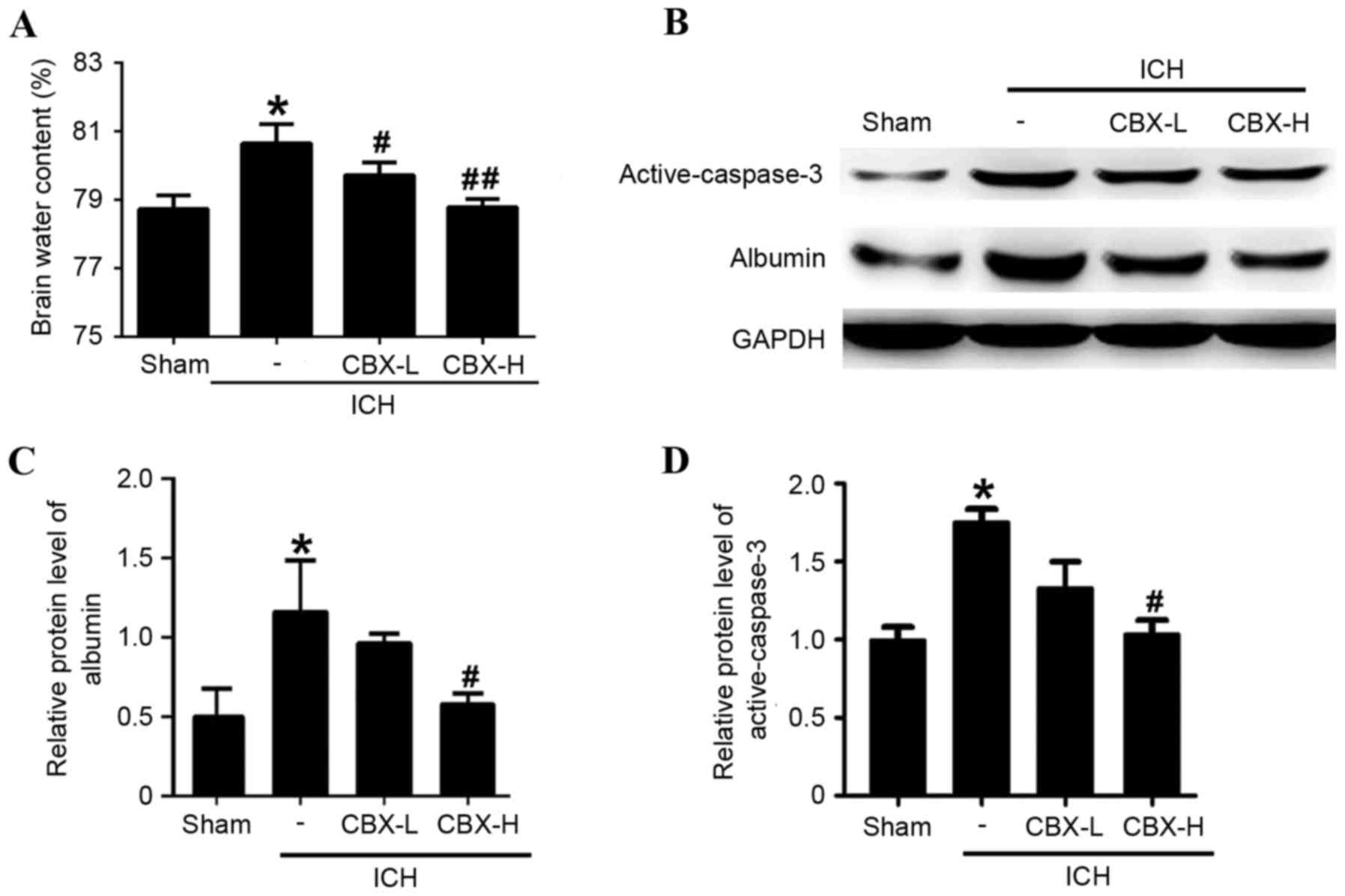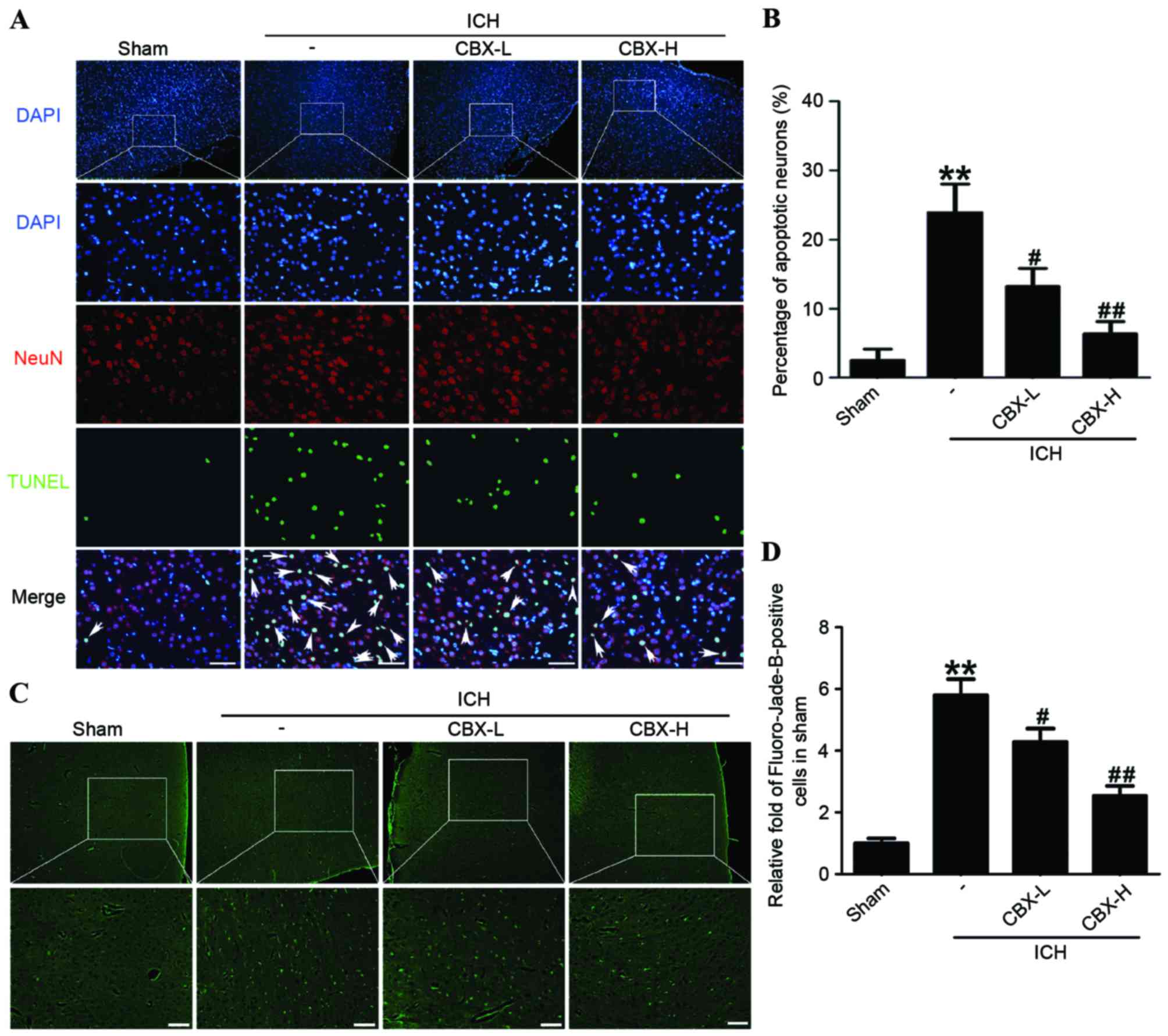|
1
|
Broderick JP, Brott T, Tomsick T, Miller R
and Huster G: Intracerebral hemorrhage more than twice as common as
subarachnoid hemorrhage. J Neurosurg. 78:188–191. 1993. View Article : Google Scholar : PubMed/NCBI
|
|
2
|
Zhang LF, Yang J, Hong Z, Yuan GG, Zhou
BF, Zhao LC, Huang YN, Chen J and Wu YF; Collaborative Group of
China Multicenter Study of Cardiovascular Epidemiology, :
Proportion of different subtypes of stroke in China. Stroke.
34:2091–2096. 2003. View Article : Google Scholar : PubMed/NCBI
|
|
3
|
Qureshi AI, Ling GS, Khan J, Suri MF,
Miskolczi L, Guterman LR and Hopkins LN: Quantitative analysis of
injured, necrotic and apoptotic cells in a new experimental model
of intracerebral hemorrhage. Crit Care Med. 29:152–157. 2001.
View Article : Google Scholar : PubMed/NCBI
|
|
4
|
Rincon F and Mayer SA: Novel therapies for
intracerebral hemorrhage. Curr Opin Crit Care. 10:94–100. 2004.
View Article : Google Scholar : PubMed/NCBI
|
|
5
|
Hossain MI, Kamaruddin MA and Cheng HC:
Aberrant regulation and function of Src family tyrosine kinases:
Their potential contributions to glutamate-induced neurotoxicity.
Clin Exp Pharmacol Physiol. 39:684–691. 2012. View Article : Google Scholar : PubMed/NCBI
|
|
6
|
Panchin Y, Kelmanson I, Matz M, Lukyanov
K, Usman N and Lukyanov S: A ubiquitous family of putative gap
junction molecules. Curr Biol. 10:R473–R474. 2000. View Article : Google Scholar : PubMed/NCBI
|
|
7
|
Zoidl G, Petrasch-Parwez E, Ray A, Meier
C, Bunse S, Habbes HW, Dahl G and Dermietzel R: Localization of the
pannexin1 protein at postsynaptic sites in the cerebral cortex and
hippocampus. Neuroscience. 146:9–16. 2007. View Article : Google Scholar : PubMed/NCBI
|
|
8
|
Iglesias R, Dahl G, Qiu F, Spray DC and
Scemes E: Pannexin 1: The molecular substrate of astrocyte
‘hemichannels’. J Neurosci. 29:7092–7097. 2009. View Article : Google Scholar : PubMed/NCBI
|
|
9
|
Thompson RJ, Jackson MF, Olah ME, Rungta
RL, Hines DJ, Beazely MA, MacDonald JF and MacVicar BA: Activation
of pannexin-1 hemichannels augments aberrant bursting in the
hippocampus. Science. 322:1555–1559. 2008. View Article : Google Scholar : PubMed/NCBI
|
|
10
|
Zhang L, Deng T, Sun Y, Liu K, Yang Y and
Zheng X: Role for nitric oxide in permeability of hippocampal
neuronal hemichannels during oxygen glucose deprivation. J Neurosci
Res. 86:2281–2291. 2008. View Article : Google Scholar : PubMed/NCBI
|
|
11
|
de Pina-Benabou MH, Szostak V, Kyrozis A,
Rempe D, Uziel D, Urban-Maldonado M, Benabou S, Spray DC, Federoff
HJ, Stanton PK and Rozental R: Blockade of gap junctions in vivo
provides neuroprotection after perinatal global ischemia. Stroke.
36:2232–2237. 2005. View Article : Google Scholar : PubMed/NCBI
|
|
12
|
Madry C, Haglerød C and Attwell D: The
role of pannexin hemichannels in the anoxic depolarization of
hippocampal pyramidal cells. Brain. 133:3755–3763. 2010. View Article : Google Scholar : PubMed/NCBI
|
|
13
|
Weilinger NL, Tang PL and Thompson RJ:
Anoxia-induced NMDA receptor activation opens pannexin channels via
Src family kinases. J Neurosci. 32:12579–12588. 2012. View Article : Google Scholar : PubMed/NCBI
|
|
14
|
Liew HK, Pang CY, Hsu CW, Wang MJ, Li TY,
Peng HF, Kuo JS and Wang JY: Systemic administration of urocortin
after intracerebral hemorrhage reduces neurological deficits and
neuroinflammation in rats. J Neuroinflammation. 9:132012.
View Article : Google Scholar : PubMed/NCBI
|
|
15
|
Okauchi M, Hua Y, Keep RF, Morgenstern LB,
Schallert T and Xi G: Deferoxamine treatment for intracerebral
hemorrhage in aged rats: Therapeutic time window and optimal
duration. Stroke. 41:375–382. 2010. View Article : Google Scholar : PubMed/NCBI
|
|
16
|
Gareri P, Condorelli D, Belluardo N, Russo
E, Loiacono A, Barresi V, Trovato-Salinaro A, Mirone MB, Ferreri IG
and De Sarro G: Anticonvulsant effects of carbenoxolone in
genetically epilepsy prone rats (GEPRs). Neuropharmacology.
47:1205–1216. 2004. View Article : Google Scholar : PubMed/NCBI
|
|
17
|
Chen G, Li Q, Feng D, Hu T, Fang Q and
Wang Z: Expression of NR2B in different brain regions and effect of
NR2B antagonism on learning deficits after experimental
subarachnoid hemorrhage. Neuroscience. 231:136–144. 2013.
View Article : Google Scholar : PubMed/NCBI
|
|
18
|
Wang Y, Gao A, Xu X, Dang B, You W, Li H,
Yu Z and Chen G: The neuroprotection of lysosomotropic agents in
experimental subarachnoid hemorrhage probably involving the
apoptosis pathway triggering by cathepsins via chelating
intralysosomal iron. Mol Neurobiol. 52:64–77. 2015. View Article : Google Scholar : PubMed/NCBI
|
|
19
|
Friedrich V, Flores R and Sehba FA: Cell
death starts early after subarachnoid hemorrhage. Neurosci Lett.
512:6–11. 2012. View Article : Google Scholar : PubMed/NCBI
|
|
20
|
Bruzzone R, Hormuzdi SG, Barbe MT, Herb A
and Monyer H: Pannexins, a family of gap junction proteins
expressed in brain. Proc Natl Acad Sci USA. 100:pp. 13644–13649.
2003; View Article : Google Scholar : PubMed/NCBI
|
|
21
|
Chekeni FB, Elliott MR, Sandilos JK, Walk
SF, Kinchen JM, Lazarowski ER, Armstrong AJ, Penuela S, Laird DW,
Salvesen GS, et al: Pannexin 1 channels mediate ‘find-me’ signal
release and membrane permeability during apoptosis. Nature.
467:863–867. 2010. View Article : Google Scholar : PubMed/NCBI
|
|
22
|
Balami JS and Buchan AM: Complications of
intracerebral haemorrhage. Lancet Neurol. 11:101–118. 2012.
View Article : Google Scholar : PubMed/NCBI
|
|
23
|
Xi G, Hua Y, Bhasin RR, Ennis SR, Keep RF
and Hoff JT: Mechanisms of edema formation after intracerebral
hemorrhage: Effects of extravasated red blood cells on blood flow
and blood-brain barrier integrity. Stroke. 32:2932–2938. 2001.
View Article : Google Scholar : PubMed/NCBI
|
|
24
|
Castillo J, Dávalos A, Naveiro J and Noya
M: Neuroexcitatory amino acids and their relation to infarct size
and neurological deficit in ischemic stroke. Stroke. 27:1060–1065.
1996. View Article : Google Scholar : PubMed/NCBI
|
|
25
|
Qureshi AI, Ali Z, Suri MF, Shuaib A,
Baker G, Todd K, Guterman LR and Hopkins LN: Extracellular
glutamate and other amino acids in experimental intracerebral
hemorrhage: An in vivo microdialysis study. Crit Care Med.
31:1482–1489. 2003. View Article : Google Scholar : PubMed/NCBI
|
|
26
|
Mailly F, Marin P, Israël M, Glowinski J
and Prémont J: Increase in external glutamate and NMDA receptor
activation contribute to H2O2-induced
neuronal apoptosis. J Neurochem. 73:1181–1188. 1999. View Article : Google Scholar : PubMed/NCBI
|
|
27
|
Thompson RJ, Zhou N and MacVicar BA:
Ischemia opens neuronal gap junction hemichannels. Science.
312:924–927. 2006. View Article : Google Scholar : PubMed/NCBI
|
|
28
|
Turpie AG and Thomson TJ: Carbenoxolone
sodium in the treatment of gastric ulcer with special reference to
side-effects. Gut. 6:591–594. 1965. View Article : Google Scholar : PubMed/NCBI
|
|
29
|
Traub RD, Whittington MA, Buhl EH, LeBeau
FE, Bibbig A, Boyd S, Cross H and Baldeweg T: A possible role for
gap junctions in generation of very fast EEG oscillations preceding
the onset of and perhaps initiating, seizures. Epilepsia.
42:153–170. 2001. View Article : Google Scholar : PubMed/NCBI
|
|
30
|
Carlen PL, Skinner F, Zhang L, Naus C,
Kushnir M and Perez VJ: The role of gap junctions in seizures.
Brain Res Brain Res Rev. 32:235–241. 2000. View Article : Google Scholar : PubMed/NCBI
|
|
31
|
Ma W, Hui H, Pelegrin P and Surprenant A:
Pharmacological characterization of pannexin-1 currents expressed
in mammalian cells. J Pharmacol Exp Ther. 328:409–418. 2009.
View Article : Google Scholar : PubMed/NCBI
|













